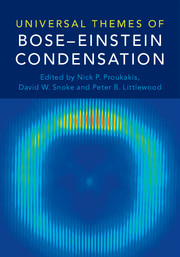Book contents
- Frontmatter
- Contents
- Foreword
- Preface
- Part I Introduction
- Part II General Topics
- Part III Condensates in Atomic Physics
- Part IV Condensates in Condensed Matter Physics
- Editorial Notes
- 19 Bose-Einstein Condensation of Photons and Grand-Canonical Condensate Fluctuations
- 20 Laser Operation and Bose-Einstein Condensation: Analogies and Differences
- 21 Vortices in Resonant Polariton Condensates in Semiconductor Microcavities
- 22 Optical Control of Polariton Condensates
- 23 Disorder, Synchronization, and Phase-locking in Nonequilibrium Bose-Einstein Condensates
- 24 Collective Topological Excitations in 1D Polariton Quantum Fluids
- 25 Microscopic Theory of Bose-Einstein Condensation of Magnons at Room Temperature
- 26 Spintronics and Magnon Bose-Einstein Condensation
- 27 Spin-Superfluidity and Spin-Current Mediated Nonlocal Transport
- 28 Bose-Einstein Condensation in Quantum Magnets
- Part V Condensates in Astrophysics and Cosmology
- Universal Bose-Einstein Condensation Workshop
- Contributors
- Index
- References
28 - Bose-Einstein Condensation in Quantum Magnets
from Part IV - Condensates in Condensed Matter Physics
Published online by Cambridge University Press: 18 May 2017
- Frontmatter
- Contents
- Foreword
- Preface
- Part I Introduction
- Part II General Topics
- Part III Condensates in Atomic Physics
- Part IV Condensates in Condensed Matter Physics
- Editorial Notes
- 19 Bose-Einstein Condensation of Photons and Grand-Canonical Condensate Fluctuations
- 20 Laser Operation and Bose-Einstein Condensation: Analogies and Differences
- 21 Vortices in Resonant Polariton Condensates in Semiconductor Microcavities
- 22 Optical Control of Polariton Condensates
- 23 Disorder, Synchronization, and Phase-locking in Nonequilibrium Bose-Einstein Condensates
- 24 Collective Topological Excitations in 1D Polariton Quantum Fluids
- 25 Microscopic Theory of Bose-Einstein Condensation of Magnons at Room Temperature
- 26 Spintronics and Magnon Bose-Einstein Condensation
- 27 Spin-Superfluidity and Spin-Current Mediated Nonlocal Transport
- 28 Bose-Einstein Condensation in Quantum Magnets
- Part V Condensates in Astrophysics and Cosmology
- Universal Bose-Einstein Condensation Workshop
- Contributors
- Index
- References
Summary
The recent experimental advances in the field of quantum spin materials have led to well-controlled systems which can be used in order to simulate complex quantum models in a clean fashion. Here we discuss how fascinating effects normally known from bosonic systems such as the Bose-Einstein condensation can be investigated with the help of such materials. We discuss as an example how a crossover between an effectively one-dimensional geometry described by a Luttinger liquid to a three-dimensional Bose-Einstein condensation can be induced. Additionally, we point out how more complex phases as the Bose-glass phase could be realized in these quantum magnets.
Introduction
Although it can seem paradoxical, the quantum magnetic states found in insulators offer an interesting route to study Bose-Einstein condensation (BEC) and more generally phenomena related to itinerant, interacting bosonic systems.
In many materials, the repulsion between the electrons causes the ground state to be a Mott insulator with one electron localized per site. In such a case, the charge degrees of freedom are completely locked by large charge gaps (usually of the order of tens of electron volts). However, one can study the fascinating physics of the spin degrees of freedom. As was shown a long time ago, the localized spins are coupled by a so-called superexchange which may be ferro- or antiferromagnetic. The properties of the exchange coupling between the spins depend mainly on the underlying atomic structure of the material. The resulting physics is extremely rich and such materials can have a host of phases ranging from ordered magnetic phases to so-called spin-liquid phases in which spin–spin correlations decay extremely fast with distance. The field of research concerning these materials, dubbed quantum magnetism, is thus an extremely active field in its own right [1].
Additionally, one can exploit the formal mapping that exists between spin operators and bosonic ones, as will be described in the next section, to connect the magnetic materials to itinerant bosonic systems with interactions between the bosons. This opens the way to use such quantum spin systems as quantum simulators. A quantum simulator means that the experimental system can be employed in order to “solve” in a controlled way a problem/Hamiltonian known from a different less controlled physical realization, e.g., inspired by fundamental many-body physics, quantum information or computational applications.
- Type
- Chapter
- Information
- Universal Themes of Bose-Einstein Condensation , pp. 549 - 568Publisher: Cambridge University PressPrint publication year: 2017
References
- 1
- Cited by



